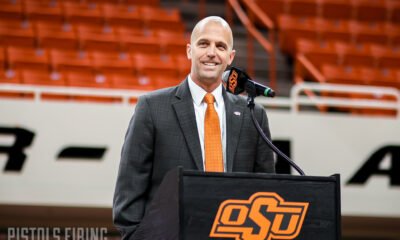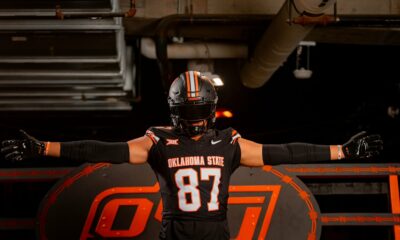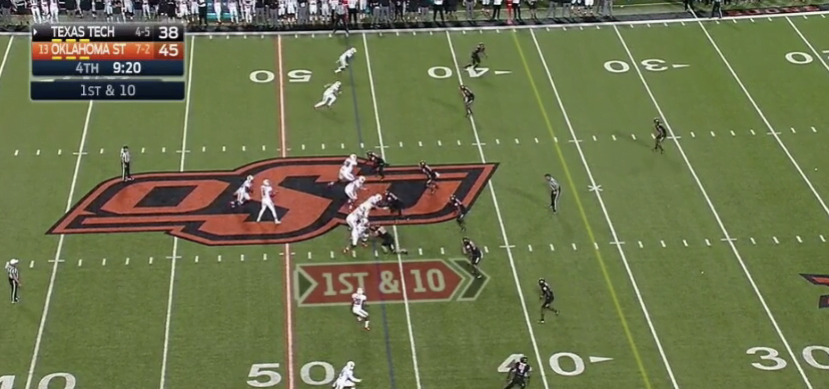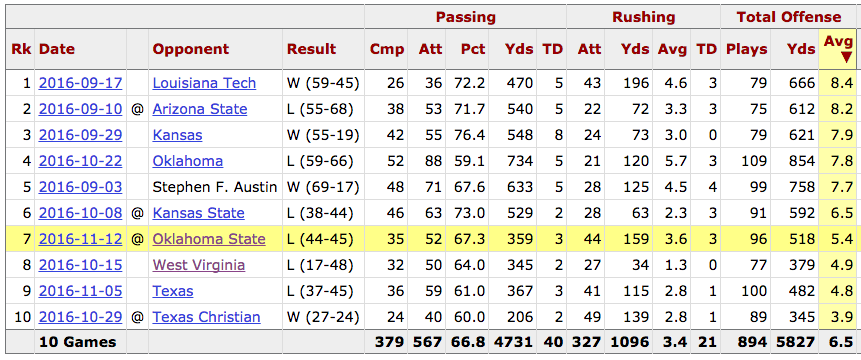Football
Glenn Spencer’s 3-3-5 Defense (Kind Of) Worked Against Tech

Facing the No. 1 passing QB in the nation is a tall task for any defense, much less one with a penchant for giving up big plays like Oklahoma State. Glenn Spencer had a plan, though. He rotated deep into his depth chart early and employed a little-used 3-3-5 defensive scheme. It’s the same formation West Virginia runs weekly. Guess who limited Texas Tech to 17 points in Lubbock? Yeah, West Virginia.
So OSU rolled with three down linemen for most of the game (see below) and dared Texas Tech to run (which it did 44 times for just 3.6 yards per carry). This worked splendidly early on — Tech ran nine plays on its first three drives and punted three times. It was startling to watch. But Tech started doing what Tech does and solved the scheme late. It closed by scoring on seven of its final 10 drives (including six TDs).
Still, OSU held the Red Raiders to just 5.4 yards per play which is what the best defenses have done against them this season. The problem is that the Cowboys didn’t convert any of the next six Tech TDs into field goals. That would have made the 3.38 points per drive OSU allowed to Tech on Sunday look a lot better.
Still, Tech had to work for it. Its shortest scoring drive was six plays. Most were tough, elongated drives that ended in scores. That matters because turnovers become more feasible and you get worn down mentally on offense if your roster isn’t deep enough.
“The risk of making a wholesale swap is whether you can make your adjustments,” Gundy said after the game of the 3-3-5 defense. “When it was taking place, I was a little uncertain. But I’m not a defensive guy, I don’t micromanage and I let people do their jobs. They felt like that was what is best, so I said ‘If that’s what you guys want and you’re comfortable with that, we’ll do it.’ I thought they were pretty dang good at it.
“There were times that we needed to make adjustments that were more difficult to make based on not knowing the in’s and out’s of the system, but I thought it was a good move…To me, it worked and I thought it was a good move. It was risky, but when you play a quarterback that is as good as (Mahomes) is, you’re going to have to take some risks. It worked out well for us.”
One of the three drives Tech didn’t score after it stalled on its first three of the game was on was the fumble OSU nabbed in the fourth quarter.
None of this would be possible without elite defensive linemen like OSU has (still can’t believe that’s a sentence I’m typing). But I think Gundy is probably right here. It seemed like a calculated risk not too outrageous for the moment. Although I’m not sure they were “pretty dang good” at it.
“We have sprinkled that scheme in, we just don’t do it on normal down defense,” added Glenn Spencer. “We have to play some three down and enter the fourth guy. You either bring four or you drop eight. It got us a few series I think and then it was players making great players. The kids practiced well. It wasn’t totally new, it was just a lot more of that.”
Mahomes got his — he always does, and this OSU defense is not elite by any stretch of the imagination. But it did get stops early and the now-flowing Oklahoma State offense (3.75 points per drive) took advantage. Spencer said it earlier in the year. It’s not one or the other. It’s how the defense sets up the offense. Or vice versa.
His crew let OSU race to a 14-0 lead early in the first quarter. It proved to be enough in the end.
Barely.

-

 Hoops5 days ago
Hoops5 days agoReport: Steve Lutz Hiring George Mason’s Mike Ekanem as Assistant Coach
-

 Softball4 days ago
Softball4 days ago‘We All Love Her to Death’: Cowgirls Will See Familiar Face This Weekend in Kelly Maxwell
-

 Football4 days ago
Football4 days agoThree-Star Tight End Jordan Vyborny Commits to Oklahoma State
-

 Football5 days ago
Football5 days agoSpring Football: OSU Returns Experience at Corner as Cowboys Look to Shore Up Pass Defense








